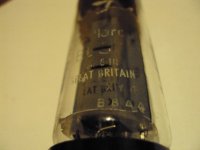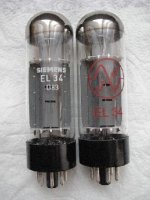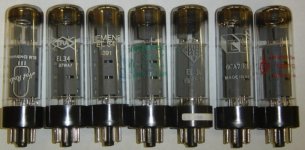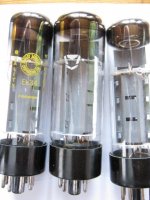rknize said:
QUOTE-> They pick-up enough of the bass that the EL34 lacks and have a nice midrange like the KT90s..
You will find the KT90 (re-geometrized sweep tube) produces double the distortion when compared to other power tubes in its class. For MI ideal. That's why your midrange probably sounds more "forward".
richy
WE91 said:Hi RJ and rknize.
Very nice, RJ, that this thread is helpful
My "checkup" (google) on the EH6CA7-EH told me that they vere close copies of the Philips and Sylvania fat bottle 6CA7's.
Fascinating observations on the 6CA7 family of tubes. I went through my pile and took a few photos. Here's some modern production ElectroHarmonix branded 6CA7EH tubes. I would assume they were manufactured in what is left of one of the old Reflektor factories, somewhere in Russia.
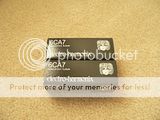
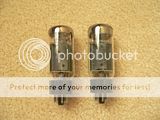
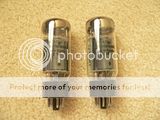
Here's a pair of slightly older Sovtek branded 6CA7. I'll assume these were also built in what was once a Reflektor factory, but perhaps not the same one as the EH shown above. Notice these guys have a square hole in the middle of the plate with a protruding tab. The EH have round holes all the way.
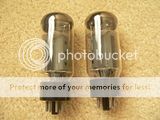
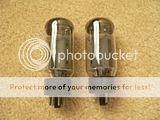
This is interesting. One has the RCA stamp on it, but clearly these were not made by RCA. In a post way up above, someone mentioned the practice of rebranding. Apparently that practice has been alive and well for a long time. One of these tubes has a Philips factory stamp on the bottom, but I haven't bothered to look up which factory. It isn't Blackburn, for whatever that's worth. Notice the hole in the key peg on the bottom of the base.
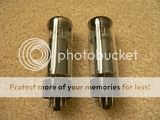


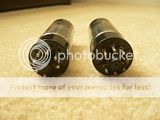

Finally, two tubes with different labels but very similar internal construction. Judging by the labels and the arrangement of the getters, I'd guess these were both made by Sylvania. One says 6CA7, the other is marked 6550. I've heard people compare the 6CA7 to a "baby 6550". Well, apparently the manufacturer felt the same way. I’ll also point out my observation that these USA made tubes look an awful lot like the Russian built tubes up above. This reinforces what Aril posted earlier.

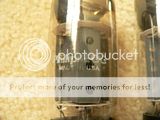


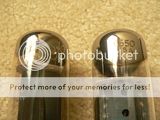

richwalters said:All the Mullard tubes manufactured in GB had a stamp code
Yes. The pic is posted up above. I hadn't previously noticed my stamp code is printed upside down! This one reads Xf3 B5H2, or maybe it's Xf3 B5HZ. Guess it's a Blackburn after all.
Ty_Bower said:
One says 6CA7, the other is marked 6550. I've heard people compare the 6CA7 to a "baby 6550". Well, apparently the manufacturer felt the same way. I’ll also point out my observation that these USA made tubes look an awful lot like the Russian built tubes up above.
Thanks for good photos Ty.
Looked at from a certain angle this indeed becomes a bewildering affair. Especially regarding anode construction one finds very different geometries but the characteristics remain the same. I have grown up with the classic description of how a beam tube operates, from which one intuitively expects a rather close conformity regarding electrode geometry. Apparently not necessary.
I have had great reservation about the innards of a KT66 and 6L6GC suddenly being identical, and had to uncomfortably accept that with characterisitcs being within 10%, I could replace the KT66 with 6L6GCs, given other advantages.
Now the EL34 in it's 6CA7 guise is the same as a 6550!? Looking up the characterisitcs there is indeed the same situation as with the KT66/6L6 spec-wise, although 6CA7 has a quite sharper cut-off, and the internal construction and dimensions are very different (I have dissected both). Looking further, one then might (within maximum limitations) also include the KT88 in the stew. Again specs. within a bracket that might be considered similar for practical purposes.
In extreme use I would accept that some types/makes would stand out; perhaps more by manufacturer than by type. But how does a designer deal with this?
Perhaps go to semiconductors? (OOPS, SORRY - er - didn't intend offence - #@$*$%&@! - I take it back
 )
)Hello everybody,
I've just bought a quartet of Siemens EL 34, I was told it was a NOS, but now I can't believe it, the tubes look the same like JJ current production including shape and even colors of the materials. Does anybody know whether it's a NOS or not
thank you
Tomek
I've just bought a quartet of Siemens EL 34, I was told it was a NOS, but now I can't believe it, the tubes look the same like JJ current production including shape and even colors of the materials. Does anybody know whether it's a NOS or not
thank you
Tomek
Attachments
Does anybody know whether it's a NOS or not.
It's not. You bought something else unfortunately.There should be a dimple on the top, not shown in the pic. Notice the 4 square holes down each side where the plates join and the big fins on top.
Attachments
here is some thread about it but unfortunately in French language 
Tube Siemens EL34 - ELEKTOR.fr | Électronique : Analogique Numérique Embarqué Microcontrôleurs Audio Test Mesure
Tube Siemens EL34 - ELEKTOR.fr | Électronique : Analogique Numérique Embarqué Microcontrôleurs Audio Test Mesure
I bought it in Poland, but the guy who sold me had bought it on ebay
EL34 SIEMENS MATCHED QUAD NOS (aukcja 260508232828) - aukcje eBay.pl | Zakupy bez granic!
EL34 SIEMENS MATCHED QUAD NOS (aukcja 260508232828) - aukcje eBay.pl | Zakupy bez granic!
here is some thread about it but unfortunately in French language
Tube Siemens EL34 - ELEKTOR.fr | Électronique : Analogique Numérique Embarqué Microcontrôleurs Audio Test Mesure
I speak French well enough to understand the contents of those posts; basically that Siemens never made it's own EL34 and that in the old days they rebranded tubes primarily made by Valvo Hambourg or Telefunken through sometime into the 1970s, and somewhat later those made by the other various Philips group of companies like Mullard, Mini-watt, RT, Dario, etc.. He also said that Siemens from the 1980s onwards rebranded RFT, Tesla, Svetlana and others. So it is quite possible that these are early 1980s Tesla production. (I have had vintage Tesla that looked exactly like these, bought by me in that time period.)
I think it was somewhat disingenuous of the seller to pass them off as what most of us think of as the Siemens EL34 (Valvo rebranded) but technically he is probably within the letter of the law. I too have been burned this way as well - you need to ask for proof that they are the vintage and construction you are expecting before you bid on them.
Based on their provenance I would say the purchaser in the auction cited above paid a bit more than what new production JJ would cost and got something comparable. These tubes in my experience sounded pretty good, but were not nearly as rugged nor long lived as Western European made EL34s. And sadly not in the same league at all with any of the Philips made tubes.
FWIW: I thought Siemens did make its own EL34 but had noted the similarity between vintage Siemens and the Valvo product. So while I suspect the French language post is definitive it might not be, and I have not checked anywhere else. So caveat emptor as the Romans say..
There's more of course, he also talks about two versions of the Tesla tube, one apparently with a (deliberately?) misaligned screen grid that generated excessive distortion and is prized by guitar players for this reason, and one that has a properly aligned screen grid. He says you can tell them apart by measuring the screen current with a plate current of 50mA: 5mA or less is a normal tube good for hifi, 10mA or higher is good for guitar amps. He recommends using either in a Marshall for a clean sound..
Last edited:
I had a similar case with some EL84's I've bought a couple of years ago.These were identical to Ei EL84's,in Siemens boxes.It is quite obvious that this was a common phenomenon with Siemens as was with others? I have seen RCA 12AX7 made by Mullard,Raytheon and Motorola made by GE,Motorola made by Sylvania,and the list has no end.Good to learn how to tell who made the tubes at least.At least it seems that these EL34's were Tesla "approved" by Siemens,sold in Semens boxes.
siemens never made EL34 and many others. they simply sourced them, most from the philips group like: Ei, Tesla ( not JJ), and ofcourss mullard, valvo, etc. later, when all tube manufacturing went down, 70s..80s, from RFT, and the companies all joined buying from RFT when their own tube manufacturing was closed. Some even let the 6CA7, 6L6 make in Shuguang, China ( for the US), Telefunken let the EL156 make in Luizhou ( china.) many shipped the tooling to here, some knowledge as well, and thats were the fun started for the chinese. before that, they got tooling and knowledge from the russians, which just copied american and european tubes.
from my knowledge, the Ei factory ( now closed) was the last one, to produce with original toolig. their El84 was the only original left also their small signal tubes, ECC83 etc., but the had big quality issues despite most materials came from germany. There is still tooling around, and i know, some people maybe try, to revive that factory under different management.
from my knowledge, the Ei factory ( now closed) was the last one, to produce with original toolig. their El84 was the only original left also their small signal tubes, ECC83 etc., but the had big quality issues despite most materials came from germany. There is still tooling around, and i know, some people maybe try, to revive that factory under different management.
A trio of 3 types of EL34. All well handled with near faded logo. The original Mullard is in centre
The LHs is a Bentley Vendor, the RHs is a Siemens Vendor. Note the anode slits of the Mullard are much smaller and has 3 rivetted in the anode plates. The mica is also different as is the base which has pin 6 omitted.
So with rebranding the name of the game, who made the Siemens ? The Bentley version has a thicker anode plate than the Siemens. The Mullard is the only authentic version.
richy
The LHs is a Bentley Vendor, the RHs is a Siemens Vendor. Note the anode slits of the Mullard are much smaller and has 3 rivetted in the anode plates. The mica is also different as is the base which has pin 6 omitted.
So with rebranding the name of the game, who made the Siemens ? The Bentley version has a thicker anode plate than the Siemens. The Mullard is the only authentic version.
richy
Attachments
- Status
- This old topic is closed. If you want to reopen this topic, contact a moderator using the "Report Post" button.
- Home
- Amplifiers
- Tubes / Valves
- Which EL34 tubes for Hi Fi
